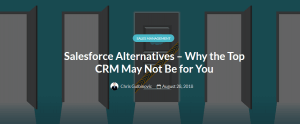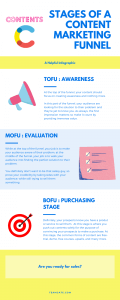Imagine this. You’ve finally launched your long-anticipated product to the world. You’ve hired the best hands and have vetted the product as a standard and quality one in its niche.
You have amazing content and all looked fine except the sales. The sales suck and it’s not promising. Let’s stop there. You know how it feels right? A lot of businesses and entrepreneurs are on this table. They have good content and good traffic but no conversion and sales.
There’s no secret in content marketing, what you are missing is a content marketing funnel. According to statistics, While 83% of B2B marketers use content marketing for lead generation, 61% of B2B marketers find high-quality lead generation a top challenge.
Irrespective of what you must have learned about content marketing, you definitely need a content marketing funnel to increase your engagement and boost sales.
Content marketing funnel lets you control what your customers think about your product and also Influences their purchasing decision.
So what exactly is a content marketing funnel? Definitely you have an idea of what a marketing funnel is, if not you wouldn’t be here. But let’s go over it again together.
What’s a Content Marketing Funnel?
A content marketing funnel is a content process that revolves around creating content in a priority and funnel type-order in order to influence customers’ purchasing decisions.
It involves creating content for each stage of the buyer’s purchasing journey from awareness of the problem to the purchase of the product (read: solution)
A content marketing funnel is an essential element of content marketing and a must for every marketer to understand. Definitely there is a good number of posts on the marketing funnel, but I will make this as simple and effective to get you rolling in sales.
Why Do You Need a Marketing Funnel?
Great you asked. What’s the need for a marketing funnel?
Wait! Let’s assume you want to convince your boss or anyone else – do it this way.
“Boss, Have you ever thought of the work of a funnel? Or why’d we needed a funnel when filling a bottle? Definitely, the funnel allows you to fill the bottle without spilling the content on the ground.
If you don’t use a funnel, there’s a high probability that you’ll spill the content on the ground.”
Same thing here. In content marketing, our greatest assets are our content. And we create great content in order to serve our audience and convert them into customers.
But here’s where we got it wrong: we keep pouring them content without taking control of how they digest content and the order of the content. We keep spilling the content all over our customers without a funnel to guide them.
You can avoid the stress and risk of sleepless nights lost to poorly implemented content marketing tactics if you use a funnel-approach.
Here’s what a content marketing funnel does, it allows you to serve your audience the right content at the right time; one at a time.
Instead of just sending your audience disorganized contents, marketing funnels allow you to send them the right one based on their stage in the purchasing funnel. Ultimately, you need a marketing funnel to control the content experience of your audience.
That said, another reason is that you want to control what your customers think about your product. If you’re not feeding your prospects what you want them to think about your product, your competitors will feed them with biased information.
Therefore, you shouldn’t leave your audience in the care of your competitors. Search for your product, and there’s a probability that your competitors are creating content about you.
So if you’re not careful, the brand you spent years to build can be destroyed by negative content marketing from competitors.
So let dive right in.
Stages of Content Marketing Funnel
As expected, a funnel has different stages and as you move down the funnel, the circle becomes smaller and smaller.
For content marketing funnel, the same principle applies. The content marketing funnel has three different stages for your prospects to move through; from the top of the funnel (a big audience ) to the middle of the funnel (a small prospect) down to the bottom of the funnel ( a smaller lead ).
The functions of the three stages are to create awareness, evaluate possible solutions, and prompt purchase of the product respectively.
Top of the Funnel (Awareness stage)
The top of the funnel is the first stage of the funnel where you generate awareness for your prospects’ problems.
Most people don’t even recognize their problems at the top of the funnel while some that do aren’t aware of the gravity of the problem. And as a marketer, your job isn’t just to sell them a product but to educate them about their problem.
Instead of telling your prospects why they should buy your product, you should start by telling them the problem they’ve got.
Sad but true, you need to sell your prospects their problems before a solution. In this 21st century, nobody wants to feel he’s been sold to. But we all don’t enjoy having problems and we wouldn’t spare a dime in solving critical problems.
Therefore, if you’re educating your prospects, dress the problem for your prospects. I’m not asking you to tell a lie. But you should emphasize what the prospects can lose if the problem is not solved.
At the top of the funnel, your prospects are searching for a more general question or problem with a less technical term.
A look at Teamgate’s marketing funnel could be of great help. Teamgate is a sales CRM tool that helps you improve conversion rates and sales.
Here’s an example of the top of the funnel content created by Teamgate.
How to Increase Sales Using the Power of Inbound Sales
Just like you, there are a lot of entrepreneurs, small business owners, and marketers that want to increase their sales. That’s the common word. And Teamgate caters for you at the top of the funnel.
To be frank, a lot of small business owners don’t even understand a Sales CRM tool. Some don’t even understand what it does.
As bad as it hurts, there are existing tools that I don’t have a clear picture of the problem they solve because I have no problem related to the product they sell.
In essence, if you’re trying to sell something to someone like me; start by creating awareness of the problem and assurance that there’s a solution.
However, at the top of the funnel, most aren’t interested in buying the solution. Better put, only a few of them are interested in paying for a solution.
Put in mind that, despite a large percentage of them aren’t interested in buying the solution, you need to be resourceful enough to get the few that are ready to take action down the funnel.
In the end, the top of the funnel is your first impression and the first impression always counts.
Middle of the Funnel (Evaluation)
Here in the middle of the funnel, your focus is on the evaluation of possible solutions.
Here your prospects are aware of their problem. And at this stage, they’re interested in comparing the possible solutions to their problems.
At every stage of the funnel, you need to prove your credibility and authority through your content.
Instead of just believing everything you say, the new age customers are good at researching and evaluating their options.
As expected, they’d confirm if they truly have a problem and if the problem is really what it’s called. Also, the possible solutions.
For Teamgate, the types of content that prospects would be a fit here are Best Sales CRM tools, {competitor} Alternatives, etc.
Definitely, Teamgate isn’t the only Sales CRM tool in the industry. Prospect will look into the other alternatives; comparing their features, reviews, and pricing plans.
At this point, the quality of your service or product will help a lot. But nothing beats good marketing.
Here’s an example of content in the middle of the funnel from Teamgate.
Best Salesforce Alternatives – Why The Top CRM May Not Be for You
Salesforce is a sales CRM tool like Teamgate and definitely one of the leaders in the industry.
And if you’re familiar with the industry, you’d agree that competing against Salesforce will be quite difficult, right? But it isn’t.
Every product has its own strength and weakness. The above content on Salesforce Alternatives is one of the best middle of the funnel content.
Teamgate starts by saying the best and most popular in the industry doesn’t mean the most suitable for your business – which is very true.
You see the difference. Absolutely, Salesforce is not an option for some businesses. Simple.
One thing to note in the middle of the funnel is that you might need to be a little biased.
While the top of the funnel is where you pass valuable nuggets without being promotional, in the middle of the funnel you need to add some promotional copies in between.
Your middle of the funnel must have a way of promoting the good qualities of your product while still promoting valuable resources for your prospects.
Notably, at this stage, your audience is smaller compared to the top of the funnel. But have a higher conversion rate than the top of the funnel.
Therefore, as you move down the funnel; you need to take your audience seriously. Because the more they move down the funnel, the more they become a valuable asset to your business.
Bottom of the Funnel (Purchasing Stage)
Finally, we are at the bottom of the funnel. If at the bottom of the funnel, you still have a reasonable number of prospects ready-turn leads; then you successfully hacked the funnel.
That’s to say, it isn’t easy to keep a larger percentage of the prospects from the middle of the funnel down to the bottom of the funnel – and it isn’t impossible.
At the bottom of the funnel is where you become very promotional and you make everything about your product.
Most of the contents created at this stage aren’t blog posts but website pages. The regular contents are pricing plans, features page, documentation, and landing pages.
However, the bottom of the funnel content isn’t limited to website pages. Creating valuable content on how to use your product is another bottom of the funnel content.
But as said earlier on, each of the stages has sub-stages which depends on the structure of your content marketing.
You can have over 20 different top of the funnel contents or even more than that.
And just as we evaluate the worth of our assets, each of the contents at the top of the funnel isn’t of the same value or position in the chain of conversion – they differ.
In essence, at the bottom of the funnel, you can have content that discusses how to use your product to solve a problem.
As expected, this kind of posts only lays emphasis on your product and nothing else. Your audience at this point knows about your product and must have heard about it, but are interested in seeing the specialties and features of your product.
Therefore, this kind of content is lower in value compared to website pages like pricing plans and features pages.
Other forms of content that worked perfectly at this stage are free trials, case studies, free demo, and onboarding webinars, and checkout page.
Find all the stages of content marketing funnel development in detail below:
Hacking the Funnel – Tested Hacks
When it comes to content marketing and funnel hacking, you have to be consistent and focused. Below are some of the proven tips to help you hack your marketing funnel.
-
Diversify your Content Types
As expected, content marketing isn’t all about creating blog posts. There are different types of content ranging from YouTube videos, podcasts, audio, eBooks, webinars, images, infographics, and many other forms.
Your priority and concern should be splitting your content marketing to accommodate essential content types. Rather than sticking to blog posts, enlarge your reach by organizing your content to include videos, images, podcasts, and many more.
If you’ve been writing blog posts, start creating videos, infographics, and many more. The content type isn’t the end goal, the end goal is sales.
-
Distribute to Different Platforms
There are a lot of platforms to share your content. We’ve blogs, YouTube, Facebook, Twitter, Pinterest, Quora, Forums, and many more.
Don’t limit your content to your website or blog, spread it as far as you can. The joy of being a content creator isn’t to just have content against your name or brand; it is to see it attract viewers and readers.
The goal should be to get your content to as many people as you can, irrespective of how they get to see your content. It could be by sharing it with your colleague or family, just keep distributing your content; that’s where viral marketing starts.
-
You Need Marketing Tools
Sad but true, you need some marketing tools to scale your content marketing. Without these tools, you can still achieve something. But when your aim is to scale your marketing campaign fast, you need a tool.
For organizing your content marketing funnel, there are a lot of content marketing tools to help you do this perfectly. Each of them has its purpose and the problems they solve.
As said earlier, you need a marketing funnel in order to provide an explicit content experience to your audience. And without the right tool, you’ll be doing hard work.
Here are some essential tools that you might be interested in if you’re on a tight budget.
- Audience Research / Keyword Research
Let’s start here. Keyword research tools are software that assists with content curation. We’ve different content marketing platforms that help with automating audience research and content creation.
Examples of content marketing platforms are SemRush, BuzzSumo, Ahref, and many more others.
- Communication Tools
Unlike other forms of content, if you’re including a free call or chat to close a deal at the bottom of the funnel; then you’ll be needing a VoIP tool.
Nextiva and GetVoip are one of the best VoIP services in the industry.
Other than a VoIP service, you’d be needing a webinar platform for hosting demos.
- Sales CRM tools
A sales CRM tool improves the customer relation of a business. Instead of making a one-off sale, a sales CRM tool allows you to cultivate the relationship beyond generating leads and sales to building a loyal customer base that keeps bringing repeat sales and business.
The sales CRM tool simplifies lead generation, contact management, and forecasting giving a detailed report of the performance of your funnel.
Teamgate is one of the best sales CRM tools in the market and a great asset for your business.
- Project Planning tools
To start with, content marketing is a long term project and requires proper planning to keep going.
You definitely wouldn’t be doing it all alone, I suppose you have a small team for content creation, distribution, and lead generation.
A project planning tool lets you assign different tasks to your team members and also track the progress of the project.
Stop Spilling Your Content – Use a Funnel
Finally, building a marketing funnel is a necessity for any business that wants to take over their sales.
If you’re concerned about your customers and your business, then you need to learn the art of strategic marketing via content marketing funnel.
I’m happy you made it down here. But, I’ll be happier if you stop spilling content all over the ground – please use a funnel.




